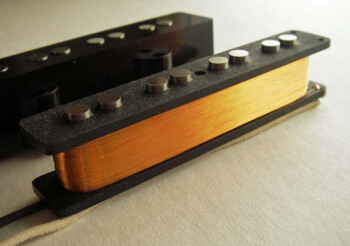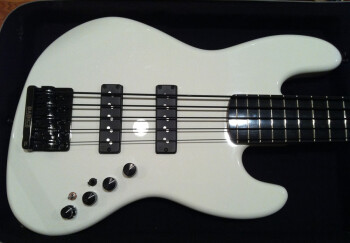Here is some basic knowledge to help you get your active bass guitar under control. As you surely already noticed, an active bass has more controls than a passive one. But keep cool, AudioFanzine is here to help you out.
Why are active bass guitars preamplified?
A pickup consists of a copper wire coil wound around a magnet. It works on the principle of electromagnetic induction, which is caused by the motion of the string in the magnetic field above the pickup. To keep it simple, the vibration of the metal string produces an electric current corresponding to its oscillation frequency. Until the seventies, guitar and bass pickup manufacturers were not able to build more powerful pickups. The technique used to increase gain was to increase the magnet size or the windings around the magnet. But unfortunately:
- Oversized magnets affect string vibration
- Too many windings cause strong radiations which capture both string vibration and unwanted noise.
Back in 1969, Alembic's founder, Ron Wikersham, had a good idea: to create the first low-impedance bass-guitar pickup. A brilliant solution: Ron’s pickups had a small number of windings, which also resulted in a low output gain (less radiations, less unwanted noise). The system included an internal preamp (built inside the instrument) to boost the low-gain signal. This innovation brought many advantages with itself and would revolutionize the bass-guitar world.
Why do active bass guitars have an EQ?
Low-impedance pickups have a wide frequency response (they perform well over a large frequency range) but lack character. The built-in EQ allows you to shape the sound. Most of the time, you’ll have two frequency bands (low and high), or even three (low, mid, high). You’ll also find systems with an active EQ (EMG), but this is quite rare. A built-in EQ allows you to boost or cut specific frequency bands. When turning a frequency-band control, you’ll notice that it has a center detent. Below this center point, the frequency is attenuated (cut); above, it’s amplified (boost). Thus it is crucial to consider the center position as the neutral setting (the zero point) instead of the fully open position.
Managing your pickups
On active bass guitars, the pickup gain is generally controlled by a master volume and a balance control instead of one single volume potentiometer per pickup. To find out, just turn the controls at random. If a single control allows you to turn the sound off, this means that you have a master volume pot.
And what about the switches?
Your bass guitar may feature one or three additional switches.
– Active/passive switch: allows you to power off the preamp to switch the instrument into passive mode. Convenient when the battery is empty, but limited if your bass has neither real passive pickups nor a passive tone control. Most of the time, active/passive bass guitars have no real passive design, so they should be used primarily in active mode. Here are the most common features:
– Pickup wiring selection: allows you to choose between serial and parallel pickup wiring. Series wiring design allows to have both pickups in the same circuit (as if you had only one pickup) to maximize output gain. The parallel design allows you to vary the sound from one pole to the other. You get less output gain but the sound is much more subtle.
– Coil selection for dual or triple-coil pickup: some bass guitars equipped with humbucking pickups give you the possibility to decide which pickup coil you want to use. This allows you to emphasize specific frequencies or maximize output gain.
– Phase invert switch: although quite rare nowadays, it can still be found on some instruments (Neuser, G&L). It allows you to switch between a full sound and a brighter but colder tone. Personally, I have never liked the out-of-phase sound.
White elephant
Please read the previous tutorial carefully.
It’s not so difficult to get an active bass guitar under control. I’d even dare say that it’s easier than a passive bass guitar. And that’s because you’re probably more used to working with EQ bands than to setting a master tone control. The workflow is more or less the same as with a passive bass guitar up to the tone setting step, which is replaced by an EQ. But before EQing, I recommend you to balance the pickups with all EQ bands set to 2/3 instead of zero. Once you find the right pickup balance tweak the mid-frequency band, which determines the dynamics of your signal depending on whether the frequency band is boosted or cut. A mid boost will work in most situations (finger picking, pick, etc.). However, for some music styles and playing techniques, cutting the mids will emphasize the bottom-end and the highs while providing sharper attacks (slap, tapping, etc.). So first you have to decide which way to go if your bass offers a mid-frequency control.
Then, you can dedicate yourself to the other frequency bands, taking the center as a starting point (to have a solid reference). Cut the lows and then increase them slowly until the sound has enough bottom. Take it easy — in most cases, when a bass sounds bad, it’s because it is too dull. Now do the same with the highs until the signal is perfectly accurate and, if needed, bright. Both high and low frequency bands affect our perception of the mid range, so fine tune the latter if needed. Set the mids to match either the low or high frequency band depending on the pickup you’re using and the position of your right hand.
A good EQ doesn’t need extreme settings. Don’t overemphasize the high and low frequency bands. I advise against cutting or boosting bands too heavily. To be effective, the EQ setting must be neither too dull, nor excessively bright nor too mid-heavy.
Like with a passive bass guitar, the goal is to find the right balance. Since low-impedance pickups have no specific sound character, only the EQ colors the signal. So set it carefully and don’t forget that you must also set your amp next!
And now, to close our introduction to bass guitars we have a last article: Setting your bass amp.



